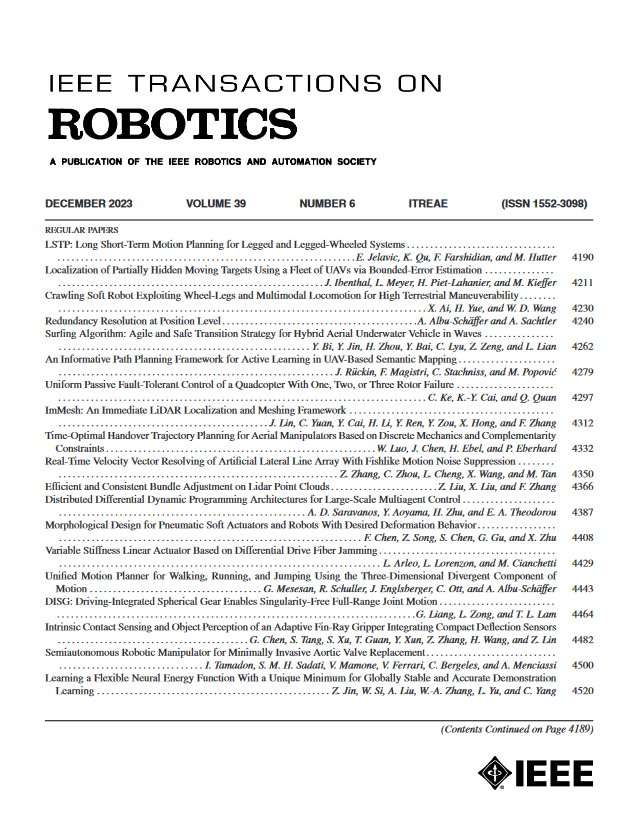面向几何广义层析触觉传感的图形结构超分辨率:在类人面部上的应用
IF 10.5
1区 计算机科学
Q1 ROBOTICS
引用次数: 0
摘要
电阻抗断层扫描(EIT)触觉传感为接触丰富的机器人系统的全身覆盖提供了很大的希望,在传感器几何上提供了广泛的灵活性。然而,尽管现有的基于深度学习的重建方法,低空间分辨率限制了其实际应用。本研究引入了EIT- gnn,这是一种图结构数据驱动的EIT重建框架,可以在机器人的无界外形因素上实现大面积触觉感知的超分辨率。EIT-GNN将任意传感器形状表示为网格连接,然后采用变压器编码器和图卷积神经网络的双重架构来最好地管理这些几何先验知识,从而实现准确,广义和参数高效的重建过程。作为概念验证,我们使用大面积面部形状传感器硬件演示其应用,这代表了人体/类人解剖学中最复杂的几何形状之一。包括仿真研究、烧蚀分析、单触压痕测试和潜在特征分析在内的大量实验证实了该模型优于其他模型。通过在人形头部运动的主动触觉伺服控制中的应用,证明了该方法的有益特性,为将设计复杂的触觉传感器集成到机器人系统中开辟了新的道路。本文章由计算机程序翻译,如有差异,请以英文原文为准。
Graph-Structured Super-Resolution for Geometry- Generalized Tomographic Tactile Sensing: Application to Humanoid Faces
Electrical impedance tomographic (EIT) tactile sensing holds great promise for whole-body coverage of contact-rich robotic systems, offering extensive flexibility in sensor geometry. However, low spatial resolution restricts its practical use, despite the existing deep-learning-based reconstruction methods. This study introduces EIT-GNN, a graph-structured data-driven EIT reconstruction framework that achieves super-resolution in large-area tactile perception on unbounded form factors of robots. EIT-GNN represents the arbitrary sensor shape into mesh connections, then employs a twofold architecture of transformer encoder and graph convolutional neural network to best manage such the geometrical prior knowledge, resulting in the accurate, generalized, and parameter-efficient reconstruction procedure. As a proof-of-concept, we demonstrate its application using large-area face-shaped sensor hardware, which represents one of the most complex geometries in human/humanoid anatomy. An extensive set of experiments, including simulation study, ablation analysis, single-touch indentation test, and latent feature analysis, confirm its superiority over alternative models. The beneficial features of the approach are demonstrated through its application in active tactile-servo control of humanoid head motion, paving the new way for integrating tactile sensors with intricate designs into robotic systems.
求助全文
通过发布文献求助,成功后即可免费获取论文全文。
去求助
来源期刊

IEEE Transactions on Robotics
工程技术-机器人学
CiteScore
14.90
自引率
5.10%
发文量
259
审稿时长
6.0 months
期刊介绍:
The IEEE Transactions on Robotics (T-RO) is dedicated to publishing fundamental papers covering all facets of robotics, drawing on interdisciplinary approaches from computer science, control systems, electrical engineering, mathematics, mechanical engineering, and beyond. From industrial applications to service and personal assistants, surgical operations to space, underwater, and remote exploration, robots and intelligent machines play pivotal roles across various domains, including entertainment, safety, search and rescue, military applications, agriculture, and intelligent vehicles.
Special emphasis is placed on intelligent machines and systems designed for unstructured environments, where a significant portion of the environment remains unknown and beyond direct sensing or control.
 求助内容:
求助内容: 应助结果提醒方式:
应助结果提醒方式:


